
Recently on Cyclingnews.com |
92nd Tour de France - July 2-24, 2005
Riding the l'Etape du Tour - July 11, 2005
L'Etape of pain and joy
By Mark Sharon
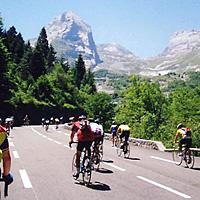
|
There are few things to envy about the life of a Tour de France professional cyclist, but one is definitely the fact that the average stage starts at a civilized 11am or noon. That gives the likes of Lance Armstrong and Jan Ullrich plenty of time to shower, shave and motivate themselves to spend another five or so hours of sinew-snapping, lung bursting effort in the saddle.
Not so for the 8000 participants of the L'Etape du Tour - the so called amateur stage of the Tour de France, organised by Velo Magazine. Our first challenge isn't a 16 kilometre slope of coal-black tarmac scorched by the summer sun - it's cranking a protesting body into action at 4.30am. Such an uncivilized wake-up is necessary to have time to cram down a couple of thousand calories of high-tech race food (and low-tech Weetabix), find that elusive right sock, and get to the start-line for the off at 7am.
Challenge number 2: locate the actual start line. An army of Gendarmes and volunteers are directing riders in a dozen different directions. The starting order is based on race number, and each rider is steered firmly into their correct start zone - it's like being one of the doors in Monsters Inc. and there are no short-cuts and no arguing with the stony-faced Gendarmes. My race number is 062 - putting me in the lead group - journalistic privilege to some - but this is my 11th Etape du Tour and let me assure you it comes with a pretty little target for the hordes of other riders to aim at.

|
Ensconced on the start line I take a moment to check my equipment and remind myself that despite nerves telling me otherwise I do still know how to ride a bike. Like everyone else I have obsessed for months about clothing and equipment choice. It's too late now to change anything. My bike, like the vast majority, is a hybrid of high-tech materials - aluminium, carbon-fibre, composites - the pros have hardly anything better - shame about the rider though. Nerves are playing havoc with my body - I feel twinges and aches which weren't there yesterday.
As the sun starts to climb higher the full spectacle of the waiting riders is revealed. We are packed into three broad avenues converging on a roundabout - three pent-up reservoirs of energy, held back by self-discipline and the flimsiest of steel barriers. The start is just minutes away and the excitement and tension is tangible. This is not just any event but a chance to pit oneself against the same terrain and conditions endured by the professionals of the Tour de France. Ahead lie 179 kilometres of rugged mountain roads, which the weather forecast promises will be baked beneath a hot sun and clear skies.
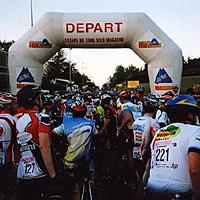
|
3-2-1 - we're off. I have time to register relief that I didn't do a Lance
Armstrong and pull my foot from the pedal as he did on the opening stage of
the Tour. There is a beep-beep as I cross the timing mat and I join what is
a truly frantic gallop. There is no looking back. Behind me 8000 others are
doing the same, though it will take a full half-hour for the last rider to cross
the start line.
Before the race I had been asked by friends and family at home about the race
- was it like the London-Brighton charity ride? For the 11th time I am reminded
swiftly that L'Etape du Tour has about as much in common with the London-to-Brighton
as the Grand National has to a pony trek. The pace is high - 25mph - and the
first 30 kilometres sweep by in less than hour - hills included.
I endeavour to appreciate the beauty of the morning and the scenery, including the still distant mountains. The streets of villages and towns are lined with people cheering and shouting. Buoyed along by the enthusiasm of the spectators and the flat-out pace I allow myself to believe I might do a cracking time for once. It's a short-lived indulgence. The race makes a right turn off the N134 into the Gorges de Lourdios and the foot of the first climb. It is a sudden reality check because the mountains start.
The most humble of the day's three big climbs, the 674m (2211ft) Col d'Ichère, still averages 7% over its six kilometres. At the foot a large yellow sign proclaims we have ridden 50 kilometres so far. It proves a decent snack ahead of the feast to come. It's 9am when I start to climb, the sun is already getting very warm, and so I switch into a low gear and spin my way up. I miss the kilometre to go mark, and suddenly I am at the summit and then descending. I take advantage of the 11 kilometres descent to the foot of the next col to munch on an energy bar and drink a bottle of water.

|
Our next test is the Col de Marie Blanque - longer at 9 kilometres, higher and more brutal than the first, it makes you pay for daring to climb to the 1034 metre summit with an average gradient of 12% over the last 4 kilometres, rearing up to 13% at one point. The first five kilometres are not exactly flat either and average 8%. The road itself basically goes straight up, barring a few gentle turns, between steep wooded slopes - lovely scenery when you are not grimacing with every pedal stroke.
A relief to the grind comes in the most bizarre way. The road narrows with two kilometres to go, funnelling riders who are only just maintaining forward momentum into ever closer proximity. There are riders walking too, not in orderly file along the side of the road, but right-up the middle. There are literally just inches to manoeuvre and the inevitable happens. Handlebars clash with handlebars and someone is on the deck. I and those behind me have no choice but to stop or ride over the prone body. I wish I had done the latter but I did the former.
I am lucky. I only have to plod up hill for a couple of hundred yards before I have space to remount - no mean feat on a 13% slope. I learn later than the traffic jam becomes so bad that back-markers are forced to walk for two kilometres.
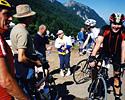
|
At last I sight the summit marker and the feedstop. The place is carnage - the floor is a carpet of crushed water bottles, orange segments and banana skins churned into a muddy quagmire. Pushing and shoving past other riders I grab what I can, and make a dash for the descent. It's chilly too and, as I descend at upwards of 80kph, dodging less courageous riders and discarded water bottles, I am glad of my windjacket. Later I discover one of my colleagues, Chris Bergman, ends up crashing on this very descent. He is taken to hospital but, fortunately, he doesn't break anything, though he does manage to slide through a cow-pat.
They say hell is down - I beg to differ. It is most definitely up. After a brief respite, descending from Col de Marie Blanque, and cruising along the valley floor to Laruns, we are on the slopes of the greatest test of the day - the Col d'Aubisque. 17 kilometres long, the road takes the race up to 1709m. The first few kilometres until the little spa town of Eaux Bonnes are through trees and average a manageable 6%, but then just when the shade disappears and the sun is at its zenith the gradient switches to 8% and more. At Eaux Bonne I snatch a quick coke from a café then steel myself for the climb proper.
The professionals are truly freaks of nature. Who can average 20km/h or more uphill in these conditions? It is like a furnace - the road has been newly resurfaced and the charcoal black surface is radiating heat like an oven. The sun is scorching the back of my neck. Everyone is suffering badly - some are walking, and along with several dozen others I seek shelter from the heat in the cool of a tunnel. The medical teams are doing a roaring trade, nursing victims of exhaustion and heat stroke.

|
The surrounding peaks ripple in the heat haze, looking starkly, brutally, beautiful. Even at altitude there's no respite from the heat and I can feel the lack of oxygen setting in. I am in my lowest gear - the so called 'Granny' gear of my triple front chain-ring. The road has become an endless series of twists and turns. Nobody is talking. All one can hear is the rumbling of motorcycle Gendarmes and the creak of bikes under strain. The ski-resort of Gourette which once loomed above us has become toy-town hundreds of metres below. That's a good sign, surely? I haven't been on treadmill after all.
At last, at last! The summit I thought I might not see before sunset. Over two hours of climbing to arrive here. I pause between gasps for air to look around me. It is actually worth the effort to be here on top of the world. The day is clear, and the mountains stretch out for miles. Apart from the briefest of climbs to the adjacent Col du Soulor - a scant three kilometres and 5% - it is downhill to Pau. Actually, Pau is still 66 kilometres away which is still a long way to go in this heat.
From the summit of the Col d'Aubisque, the descent runs along the Corniche du Cirque de Litor - a stunning piece of road carved into a sheer slope. Just a low stone wall lies between the road and free fall to the scree slope a long way below. If I never get to the Etape again, this piece of road alone will be what I remember best of all the Etapes.
The trials of the climb are a distant memory as I let gravity take me along for the ride of a lifetime. It is a shame it is over so soon, but not for long. The Col du Soulor briefly interrupts the descent with a three kilometre climb at 6%, though it feels like six kilometres at 12% at first, and then it is back to an even longer descent. I realise as we lose height that it was actually cooler at altitude, and decidedly less humid.
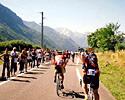
|
Descending is one of cycling's art forms. A great descender is an amalgam of bike and rider. Holding one's nerve is essential, as is the ability make small shifts of weight and direction work in harmony. When all you have is a couple of square centimetres of siliconised rubber in contact with the road there isn't much scope for error.
The current debate raging amongst cyclists is all about the correct cornering technique - particularly about the use of so called counter-steering. According to Lance Armstrong, with whom I discussed this a few seasons ago, the technique is not to turn the handlebars, but to push down on the side you are cornering. The bike then carves, cuts, or whips around the corner, depending which aficionado you are talking to at the time. It is something better done than talked about I feel.
I have no idea whether I was doing it right, but I managed to get to the bottom of the descent without colliding with the slope or sailing off into space. Unhappily others were not so lucky. At one point I passed a rider lying unconscious on his side in the middle of the road, his head in a pool of blood. A medic was already with him, her face clouded with concern. It was a stark reminder that cycling is a dangerous sport.

|
Ahead the road was described as flat in the race blurb. Compared with the previous 120 kilometres it was, but it still proved to be on the hilly side. The best way to cover long distances in a race is to find a bunch rattling along at the same speed and tuck in. The effect of riding in a group can increase the average speed considerably. The downside is that occasionally each rider has to take a turn at the front while everyone shelters behind them.
With 15 kilometres to go I check the race profile on the pocket route plan the organisers give each rider. Just before the end are two little bumps. Well they were little when I had the Col d'Aubisque to contend with. Now they loomed ahead like a mini-mountain range in their own right - tree covered wall between me and a cold beer. The sun was continuing to beat down remorselessly, but now I was at the end of strength too.
Now halfway up the penultimate climb it was all I could to weaving from patch of shade to shade, taking drinks from anxious spectators who would give the occasional push. Then just when I felt that exhaustion and demoralisation would finish me off I saw the most amazing and humbling sight. Ahead of me a man mis-cued a turn and fell to the ground. A crowd quickly gathered to help. As I drew level I had to do a double take. The man was picking his arm up off the road. Then I noticed that not only was his right arm false, but so was his right leg! A few minutes later he passed me, being pushed, up-hill, by another rider. It immediately made me feel I had no right to feel tired.
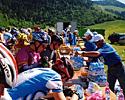
|
With five kilometres to go I fell in step, or pedal stroke, with a woman called Claire Culver. Women form a tiny minority in this event - numbering just a couple of hundred out of 8000 - and the crowd save the biggest cheers for them. At the risk of generalising they certainly deserve the applause because certainly in the case of the women I ride with those who take part in this event have probably trained much harder than the majority of the men.
The last challenge is just 50 metres long, comprising a short sharp climb on to Pau's Place du Verdun and the finish line - the Ligne d'Arrivée. My relief is immense but so is my surprise that I am actually here before the sundown. Actually, I am almost an hour inside the cut-off time, finishing in 7057th in 9h 46' 31". My exhaustion is overwhelming. I sob into the phone to my wife back in the UK. Only one thing left to do - far more important than showers and meals - find the café with my friends and drink copious amounts of ice-cold beer.
Photography
For a thumbnail gallery of these images, click here
Images by Mark Sharon
- All set and ready to start on their toughest rides ever
- What a sight as the riders climb the Col d'Aubisque
- Above Gourette as riders climb the Col d'Aubisque
- That's huge! Corniche Cirque de Litor makes ants of men
- En route to the Col d'Aubisque
- Entry to the start village
- Information for the ride ahead. All you need to know is that it's going to hurt!
- It's a feedstop frenzy as riders try and reload for the gruelling miles ahead
- Near Col d'Ichere in the perfect afternoon sunshine
- Le grand depart
- I made it! At the summit of the Col d'Aubisque
